If you want to know about the lighting design in a building or introduction of electricity production or placement of electric equipment in building, please click the link.
There are many different types of lamps available, each with their own unique features and benefits. Here are some of the most common types of lamps:
1) Types of lamps
i) LAMP / working tool
- A lamp is an energy converter. Although it may carry out secondary functions, its prime purpose is the transformation of electrical energy into visible electromagnetic radiation.
- There are many ways to create light. The standard method for creating general lighting is the conversion of electrical energy into light.
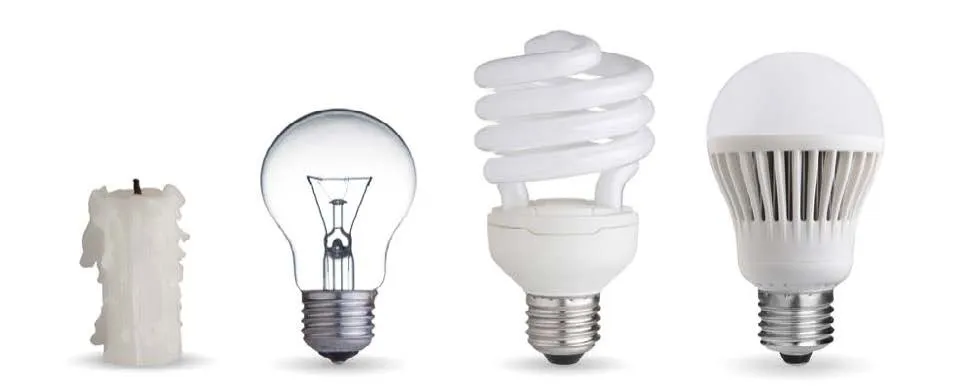
- A lumen is a measure of how much visible light is emitted by a source. Lumens per watt (lm/W) refers to the energy efficiency of lighting: how much visible light you get for a given amount of electricity.
2) Incandescent Lamp
These are the most common type of light bulb and work by passing an electric current through a wire filament, causing it to heat up and emit light. They are relatively inexpensive but not as energy-efficient as other types of lamps.

- These lamps use a tungsten filament in an inert gas or vacuum with a glass envelope. The inert gas suppresses tungsten evaporation and lessens the envelope blackening. There is a large variety of lamp shapes, which are largely decorative in appearance
Working
- Lamp work on the principal of Incandescence ( i.e. when a hot body is heated, radiant energy is emitted in waveform).
- An incandescent bulb generates light through heat.(95% Heat,5% Light)
- When electrical current passes through the tungsten filament, it heats to the point where it glows and gives off a yellow-red light.
- To keep the filament from burning up immediately, it’s housed in a vacuum.
- Even so, the intense heat of the filament ensures a comparatively short and expensive life span.
Applications
- Incandescent lamps are still popular for domestic lighting because of their low cost and compact size. However, for commercial and industrial lighting the low efficacy generates very high operating costs, so discharge lamps are the normal choice.
Efficiency
- 15–40–100 W tungsten incandescent (230 V) (120 V)
- Luminous efficiency of incandescent lamp is about 15 lumens per watt.
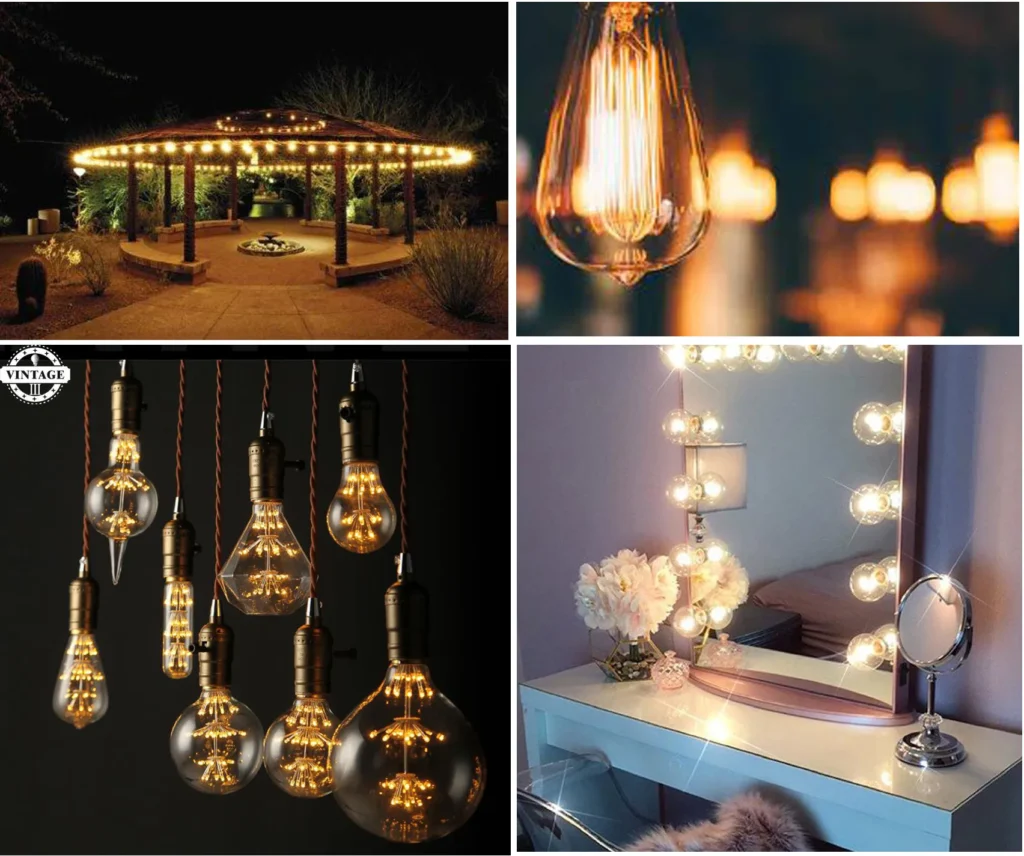
3) Tungsten halogen lamps
These are similar to incandescent lamps, but use a halogen gas in the bulb to increase the efficiency and lifespan of the filament. They produce a brighter, whiter light and are often used in task lighting.
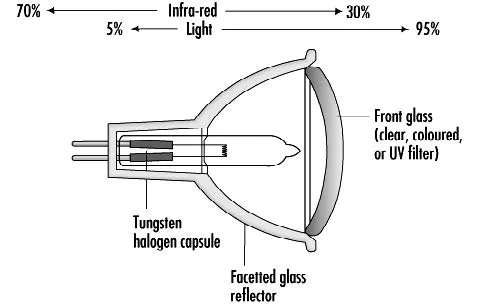
- A halogen lamp consists of a tungsten filament, which is sealed with a compact transparent envelop and filled with an inert gas and small amount of halogen (bromine or iodine). These lamps are smaller than the conventional lamps. Halogen increases the lifetime and brightness of the lamps.
Working
- These are similar to incandescent lamps and produce light in the same manner from a tungsten filament. However the bulb contains halogen gas (bromine or iodine) which is active in controlling tungsten evaporation.
- Most tungsten halogen lamps have an improved life over incandescent equivalents and the filament is at a higher temperature, creating more light and whiter colour.
Applications
- Typical examples are stage lighting, including film and TV, where directional control and dimming are common requirements
Efficiency
- 2.6 W tungsten halogen (5.2 V)
- Tungsten quartz halogen (12-24 V)
- Luminous efficiency of a halogen lamp is about 25 lumens per watt.
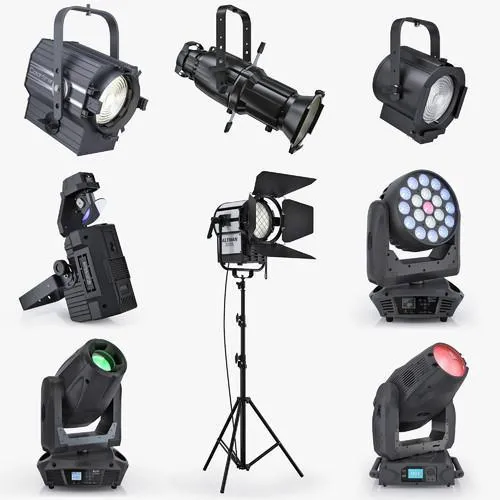
4) Fluorescent Tube
These lamps use a gas and a small amount of mercury vapor to produce ultraviolet light, which in turn causes a phosphorescent coating on the inside of the lamp to emit visible light. They are very energy-efficient and often used in commercial and industrial settings.

- A fluorescent tube is a gas discharge tube that uses a fluorescence to produce visible light Fluorescence is the emission of light by a substance that has absorbed light or other electromagnetic radiation.
Working
- Cathode filament emits electrons after getting heated due to supply of current . These electrons while accelerating collide with Argon and Mercury vapour atoms. The excited atoms of Mercury give a radiation
Applications
- In the US, fluorescent lamps are mostly found in kitchens, basements, and garages.
- In countries, like India… i) Residential. ii) Commercial. iii) Small scale industries
Efficiency
- 32 W T12 tube with magnetic ballast
- Luminous efficiency of a fluorescent tube is about 45 to 100 lumens per watt.

5) Compact Fluorescent Lamp
These are a type of fluorescent lamp that are designed to be more compact and fit into standard light fixtures. They are very energy-efficient and can last up to 10 times longer than incandescent lamps.

- A CFL is designed to replace an Incandescent lamp. Generally, CFLs use less power, produce same amount of light and have long lifespan.
Working
- In a CFL, an electric current is driven through a tube containing argon and a small amount of mercury vapour. This generates invisible ultraviolet light that excites a fluorescent coating (called phosphor) on the inside of the tube, which then emits visible light
Applications
- Residential applications replacing incandescent and halogen lights
Efficiency
- 9–32 W with magnetic ballast
- Luminous efficiency of a compact fluorescent lamp is about 60 lumens per watt.
6) High Intensity Discharge Lamps
These are used for outdoor lighting, streetlights, and other industrial applications. They work by passing an electric current through a gas or metal vapor to create light.

- High-intensity discharge lamps (HID lamps) are a type of electrical gas-discharge lamp.
- Metal halide, mercury vapour, self-ballasted-mercury lamps and high-pressure-sodium lamps all are high intensity discharge lamps. These lamps are specially designed with inner glass tubes that include tungsten electrodes with electrical arc.
Working
- It produces light by means of an electric arc between tungsten electrodes housed inside a translucent or transparent fused quartz or fused alumina arc tube.
Applications
- High-intensity-discharge lamps are normally used when high levels of light are required over large areas which include outdoor activity areas, gymnasiums, large public areas, pathways, roadways and parking lots.
Efficiency
- high luminous efficacy of around 75–100 lumens per watt
7) Sodium lamps
The low-pressure sodium lamps
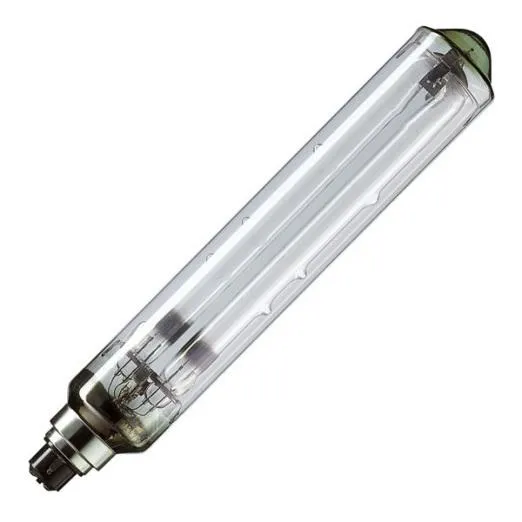
Advantages
- Very efficient lamp
- Powerful lamp for use of large areas
- Despite a warm up time of 5-10 minutes it restarts immediately if there is a brownout
- Lumen output does not drop with age (such as in LEDs or incandescents)
Disadvantages
- Worst color rendering of any lamp
- Sodium is a hazardous material which can combust when exposed to air (such as if the bulb is broken in the trash)
The High-pressure sodium lamps
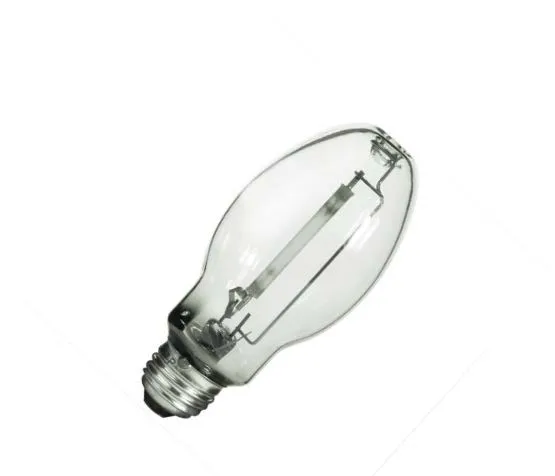
Advantages
- Good efficiency (lumens per watt)
- Smaller size than LPS or fluorescent, the HPS fits into many fixture types -Can be retrofitted into older Mercury Vapor fixtures -better bulb life than LPS lamps
Disadvantages
- Still has a bad colour rendering compared to metal halide and halogen lamps
- Requires a lossy ballast (inefficient) that operates a low arc voltage of 52-100V. This reduces the actual efficiency of the lamp when you
8) Light Emitting Diode
These use light-emitting diodes to produce light and are extremely energy-efficient, long-lasting, and come in a wide range of colors. They are becoming increasingly popular in both residential and commercial settings.

- Latest Lighting Technology.
- The LED is a special type of diode and they have similar electrical characteristics of a PN junction diode. Hence the LED allows the flow of current in the forward direction and blocks the current in the reverse direction.
Working
- When the diode is forward biased, then the electrons & holes are moving fast across the junction and they are combining constantly, removing one another out. Soon after the electrons are moving from the n-type to the p-type silicon, it combines with the holes, then it disappears.
- Hence it makes the complete atom & more stable and it gives the little burst of energy in the form of a tiny packet or photon of light.
Applications
- Signs and Traffic signals.
- Displays.
- Exit signs.
- Indicators and Flash lights.
- Under counters.
Efficiency
- 130 lumens/watt.
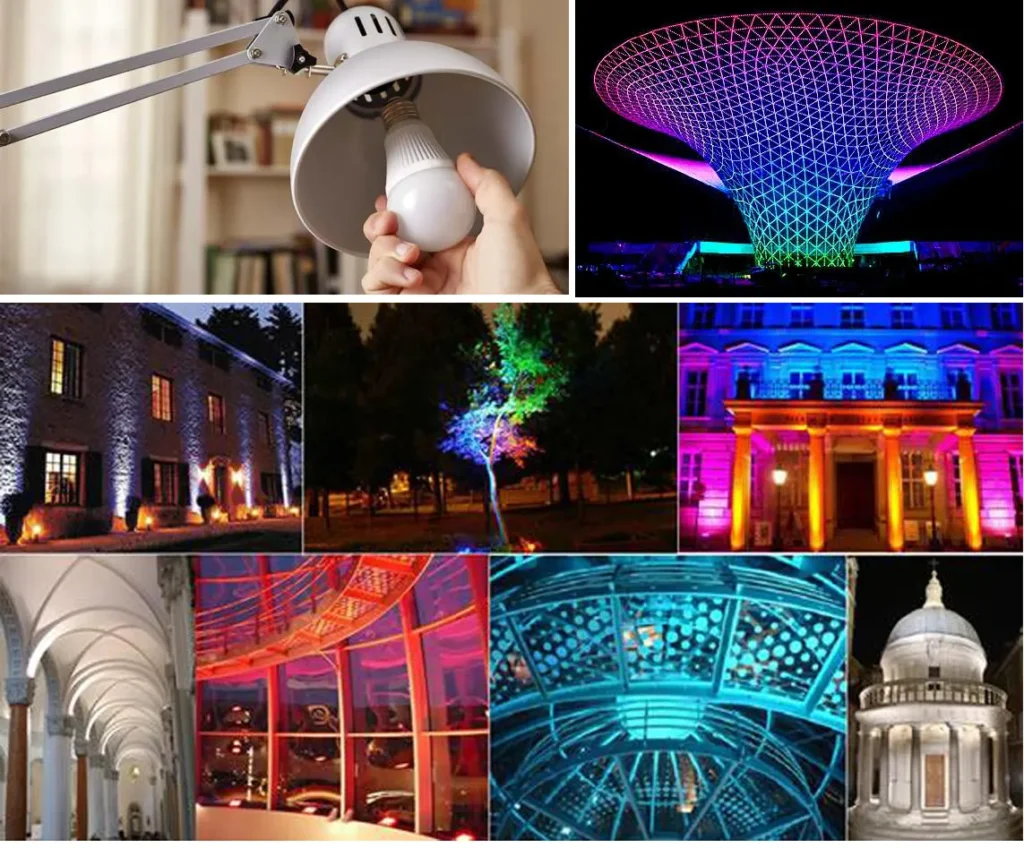
Advantages of LED lamps
- LED lamps present a number of advantages with respect to high pressure lamps of mercury (HPMV) and sodium (HPSV):
- Very low power consumption, down to 80% lesser.
- They produce a very low amount of heat.
- They last a very long life (very long mean efficient life).
- They bear numerous switching on/off cycles.
- They light instantaneously after switching on.
- They can produce any colour shade to fit to their use.
- They are highly ecological (without any pollutant and 100% recyclables).
Advantages of LED lamps: ECOLOGICAL ASPECTS
- No mercury present
- No emission of ultraviolet light
- Their low power consumption makes lower CO2 emissions
- Their long duration implies lower expenditure of raw materials and lower waste production
- Fully recyclables at the end of their useful life
9) L.E.D Strip
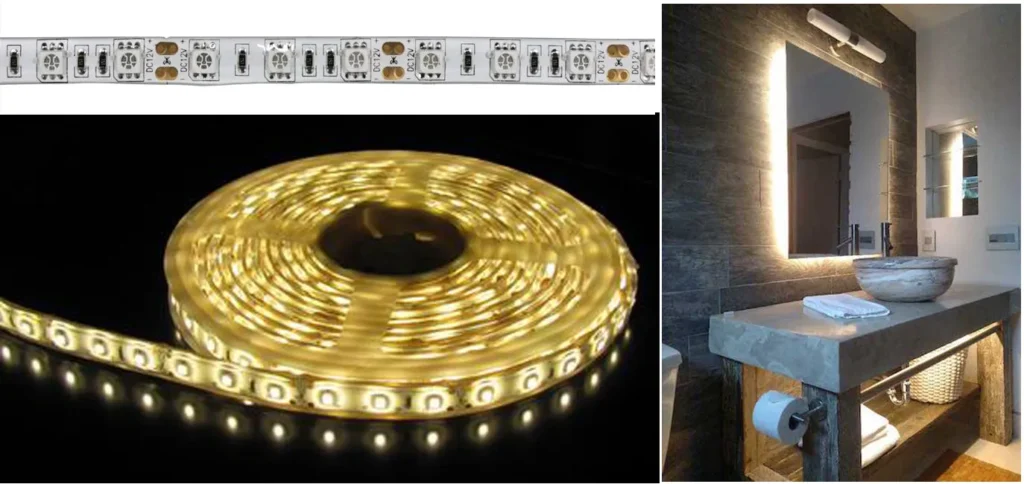
- An LED Strip Light (also known as an LED tape or ribbon light) is a flexible circuit board populated by surface mounted light-emitting diodes (SMD LEDs) and other components that usually comes with an adhesive backing.
Applications
- Traditionally, strip lights had been used solely in accent lighting, backlighting, task lighting, and decorative lighting applications.
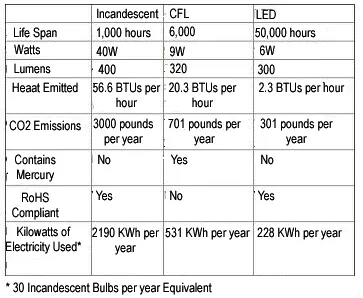
Comparison of mercury vapour, metal-halide and high-pressure sodium lamps
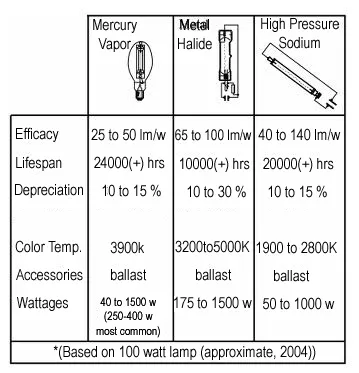
There are several different types of lamps available, including incandescent, halogen, fluorescent, LED, compact fluorescent, high-intensity discharge, neon, salt, and smart lamps. Each type of lamp has its own unique features and benefits, ranging from energy efficiency and long lifespan to different colors and therapeutic effects.
Some lamps are designed for specific uses, such as outdoor lighting, while others are more commonly used for decorative or ambient lighting. Smart lamps can be controlled using a smartphone app or other smart home devices.